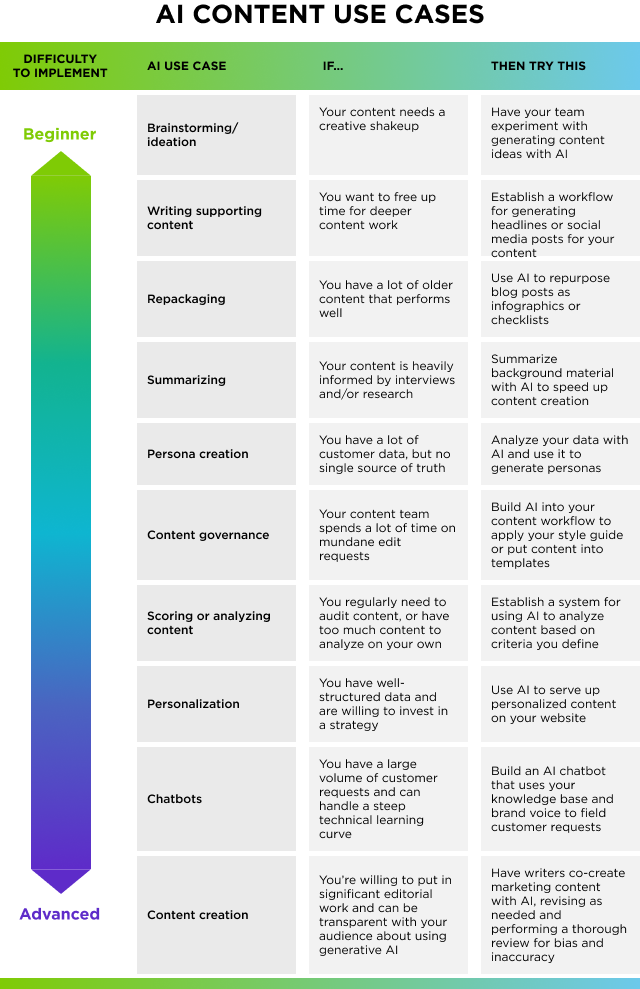It seems like every week, there’s something new to learn about AI. It’s tempting to feel like you’re falling behind in your AI content strategy—and to try to make up for it by doing all the things to supercharge your adoption of AI.
But that’s exactly the wrong approach. AI content creation is tricky to get right, and in many cases it can open you up to risk. Some of the most frequently cited use cases for AI in content are also some of the hardest to implement.
That’s why at Tendo, we advise starting small. Instead of trying to use AI to launch your entire content marketing campaign or generate polished, original thought leadership, think about using it for common, repeatable content processes.
The chart below shows 10 potential use cases for AI in content, ranked from easiest to most difficult to implement. In this post, we’ll explore which ones are beginner-friendly, which ones can pay off after a little research and preparation, and which ones to leave to the experts.
Start Simple: AI Content Use Cases for Beginners
These use cases don’t require intensive preparation or advanced prompt engineering, and it’s easy to check the output for inaccuracy or bias. Because they don’t use private data, they’re low risk and can be performed with public tools like ChatGPT. They provide a safe way for your team to begin experimenting and building confidence with AI.
Brainstorming and Ideation
You probably already know that AI is good at coming up with ideas. Publishing AI-generated content comes with risks, but when it comes to ideation, the whole point is to go wild and generate ideas that may or may not ever see the light of day. It’s the perfect sandbox for your team to start getting comfortable with AI—and it may result in some creative new content ideas.
Writing Supporting Content
Ever written a killer blog post and then struggled to come up with a compelling headline before hitting “publish”? Then you already understand how much time this AI content use case can save. Executive summaries, social posts to promote an asset, even alternative text for image accessibility—if it’s based on content you’ve already created, AI can write it.
These supporting content types have a couple things in common: They’re generally short, so it’s easy for a human editor (ideally the writer of the source content) to review them for accuracy. They’re also extremely important, and often overlooked. This isn’t the place to get lazy—it’s a good practice to use AI to generate multiple versions of a headline, and to iterate until you have something great.
Repackaging Existing Content
This is the kind of thing AI excels at: turning an ebook into copy for an infographic, or a white paper into a checklist. It’s a great way to get value from older content that still performs well. And since the source content is already public, data privacy isn’t an issue. Not sure where to start? Try asking AI to generate ideas for you.
Grow Your AI Content Operations: Intermediate AI Content Use Cases
As your team becomes more knowledgeable about AI, you can expand into these intermediate use cases. However, they require the use of internal data like interview notes, customer information, and unpublished content pieces, so before you try them, you’ll want to be set up with an enterprise generative AI solution that keeps your data private. They may also require some work to write effective prompts and then build them into your content workflow, but once you’re up and running, they can add a significant amount of value.
Summarizing
If your content is heavily informed by interviews or research, the summarizing capabilities of generative AI are a godsend. And it doesn’t require specialized prompting—simply paste your background information in and ask for a summary. We’ve labeled this an intermediate use case because it could involve sensitive data. So before you give your content team the go-ahead to use AI to summarize, make sure you’re running a private AI instance and that everyone knows the risks of using AI.
Persona Creation
If you have high-quality research on your customers, persona creation is really a matter of summarizing that data–and that’s something we already know AI can do. Of course, this comes with the same data and accuracy risks as summarizing. And since personas follow a specific format, prompting AI to create them takes a bit more finesse.
Always remember that AI is not a substitute for research: It uses prediction and probability in place of actual insight. But if you can supply the insights, AI can distill them into a format that your marketing team can use.
Content Governance
When your content team spends more time on mundane edit requests than they do on creative strategy, you know it’s time to bring in content governance tools. And if you can build AI into your content workflows to put content into templates or make sure it follows your brand style guide, so much the better.
The challenge here is making sure things are done well. Getting AI to correctly apply content governance guidelines requires prompt engineering, training, testing, and correcting until you’re confident in your approach. And even then, you’ll want a human editor to cast a quick eye over the results.
Scoring or Analyzing Content
Content audits are a rich source of insight into what you could be doing better. But they’re time-consuming. Teaching AI to analyze content based on criteria you define? Well, that’s also time-consuming, and it takes a fair bit of prompt engineering and experimentation to make sure you agree with the AI’s assessment. But once you have a system set up, the time savings can pay off. If you audit your content regularly, investing in this use case is a good idea.
Why You Shouldn’t Start with Content Creation: Advanced AI Content Use Cases
Chatbots and content creation are the generative AI use cases that come to mind first for most people, but they’re actually not the best place to start. These advanced use cases require a lot of upfront work and awareness of the potential pitfalls of generative AI. They may also require technical knowledge to implement.
Personalization
Delivering personalized content is complicated, even before you bring generative AI into it. Effective personalization requires actionable customer data, a strong taxonomy, and a robust digital experience platform or personalization engine. Adding AI into the mix requires investing in even more technology that has to integrate with your CRM and customer data. On top of that, if you’re using AI to generate personalized content on the fly, there’s no layer of human review between you and the customer. This has real risks for your brand, and it’s something you only want to attempt if your confidence in your tech stack and AI fine-tuning is rock solid.
Chatbots
Now we’re getting into real risky territory, as Chevrolet of Watsonville famously discovered when users tricked its ChatGPT-powered customer service chatbot into writing code, explaining why Tesla is better than Chevrolet, and selling a 2024 Chevy Tahoe for $1. The addition of user input means that things can quickly go off the rails. If you have the resources to invest in a chatbot platform, the technical ability to train a chatbot on your brand voice and fine-tune it to only respond to certain queries, and the time and resources for thorough testing, an AI-powered chatbot might be worth your while. Otherwise, proceed with caution.
Content Creation
Right now, you might be saying, Wait—isn’t AI content creation the whole reason we’re here? And technically, some of these use cases (like repackaging and headline writing) are creating content with AI. But the content in those instances is tightly defined, controlled, and reviewed.
It’s worth restating that generative AI works by predicting the most likely next word—which means that often, what it generates is just a bland average of all the content that exists on a topic. So if you’re hoping to use AI to write groundbreaking thought leadership or creative, attention-grabbing marketing copy, you’re probably going to be disappointed. There are ways to generate content with AI that’s interesting and on-brand, but they involve careful prompting and iteration, and even then, your content will need to be thoroughly edited and reviewed.
Work with Tendo to Put AI into Practice
Deciding where to start with AI requires strategic thinking and a thorough understanding of your resources, capabilities, and limitations. But if you play it right, you can ramp up slowly and expand your expertise until you’re ready to take on even the most advanced AI use cases.
Ready to start putting these AI use cases into practice? Talk to Tendo about an AI content playbook for your business.











